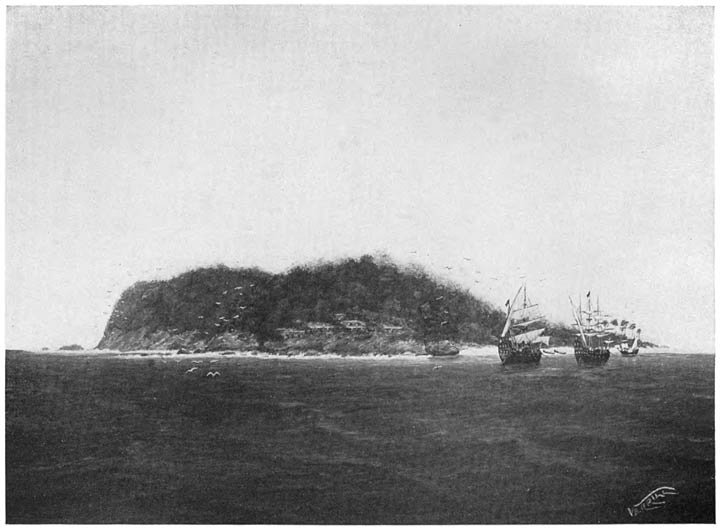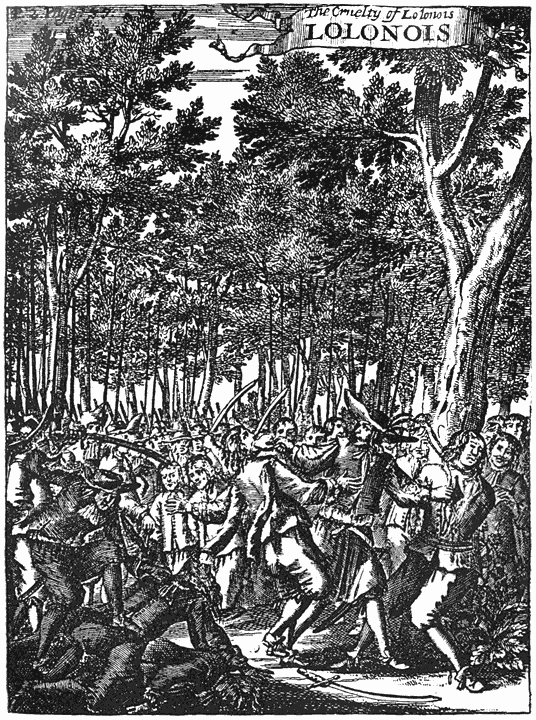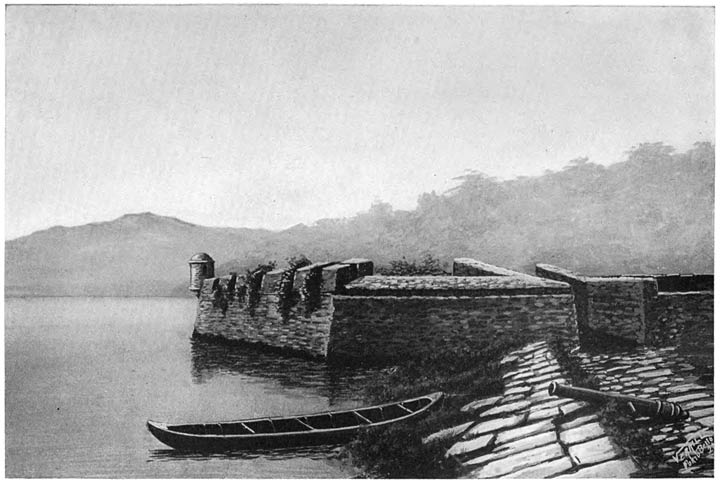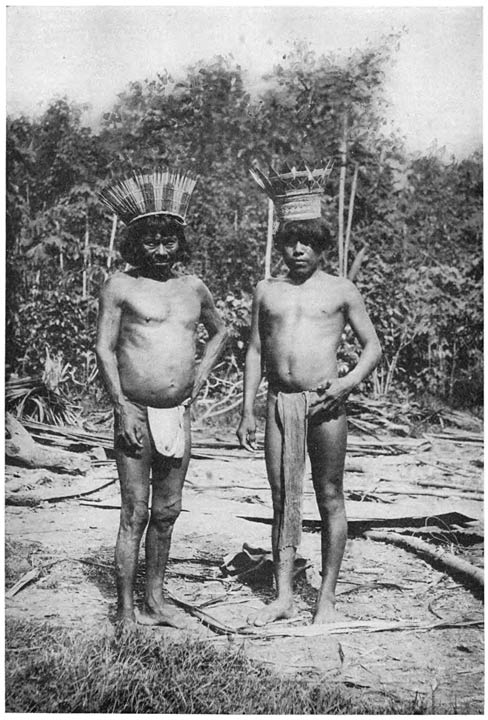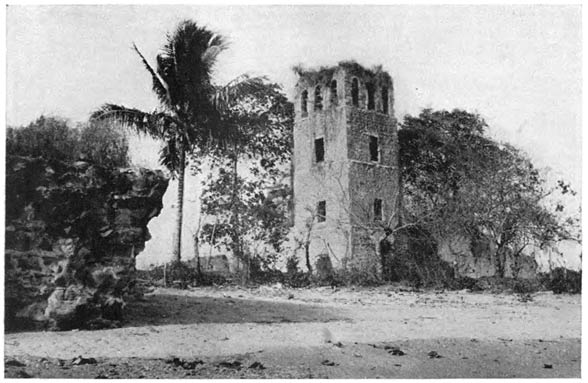
IN THE WAKE OF
THE BUCCANEERS

THE DANGEROUS VOYAGE

THE BUCCANEERS
NEW YORK AND LONDON ☙ ☙ MCMXXIII
INTRODUCTION
There is no more entrancing body of water in either the Western or the Eastern Hemisphere—than the Caribbean Sea, with a fringe of lovely tropical islands on the one side and on the other the Spanish Main and its picturesque centuries-old towns and fascinating sights. Aside from its beauty, its delightful climate, and its ever-shifting scenes, the Caribbean and its shores are redolent of romance. It was the starting-point of those brave though ruthless adventurers who carved a new world for Castile and Leon. For centuries it was the treasure-house of the world and the battle-ground of the mightiest European powers. Across this sapphire sea sailed the caravels of Columbus, the Golden Hind of Drake, and the stately, plate-laden galleons of Spain.
And across this same sea coursed those fierce sea-rovers the buccaneers.
Of all the dare-devil spirits who sailed the Caribbean and ravaged the Spanish Main, the buccaneers were the most picturesque and romantic. [vi]Villains though they were; reddened with the blood of the innocent and helpless though their hands; black-hearted cutthroats beyond denial—yet there is something about them that appeals to all, and that, despite their ill deeds, fills one with admiration.
Perchance it is the fact that we all appreciate bravery—and, notwithstanding their multitude of sins, the buccaneers were brave beyond compare. Again, it may be that in all of us lurks a little of the gambling spirit and we admire those who can take a chance, even though we do not, and no greater gamblers ever lived than the buccaneers. They staked their lives at every turn, they gambled with death, and the greater the odds the more readily did they throw themselves into the game. And it was this gambling spirit, this recklessness that enabled them to defy the world of their day.
We hear much of the bold, wild ways of these adventurers; we have been taught by history and tradition to consider them devoid of redeeming qualities, and few of us realize that the buccaneers were far from being true pirates, that they were not alike, that many were corsairs through force of circumstances rather than by choice, that they had their own laws and code of honor, and that they were a most important factor in shaping the [vii]destiny of the New World. To them, incredible as it may seem, we owe an immense debt of gratitude. Had it not been for them the British never would have retained their foothold in the Caribbean, and we, to-day, might be under Spanish rule. Many of them, too, were educated men and left us records which are of incalculable scientific or historic value; for example, Dampier, who was a keenly observant field naturalist and devoted far more of his time to penning descriptions of fauna and flora than to slitting Spanish throats;1 and Esquemelling,2 the erstwhile accountant, who [viii]left us a classic as a result of his years as a ship’s supercargo among the buccaneers.
Yearly, Americans by the thousands flock southward to tour or to stop for a time in the West Indies or about the shores of the Caribbean, but few of these are aware of the intimate associations with the buccaneers which all these places hold. Yet we may dwell in the very hostelry wherein pirate chieftains reveled and spent their ill-gotten gold; we stroll through little towns which have echoed to the ribald songs and lusty shouts of roistering pirate crews; we sail, in palatial steamships, above the long-forgotten hulks of burned and scuttled galleons, and we haggle with shopkeepers or native boatmen in whose veins may flow the blood of Morgan, Hawkins, or Montbars.
Bereft of the buccaneers, the Caribbean and its shores lose their greatest fascination, and as the most desirable localities are those intimately associated with the sea-rovers and their deeds or misdeeds, it seems fitting to travel about the Spanish Main and the West Indies in the wake of the buccaneers.
It is to point out the romantic associations of [ix]these waters and islands and make a visit to them more interesting, to weave a little of the lives and deeds of the buccaneers into the story of the locality, and to give brief sketches of the most noteworthy, while at the same time describing the places, their attractions, and their present condition, that this book has been prepared.
So much of a purely fictional nature has been related of these sea-rovers that many of the statements contained herein will come as a distinct surprise, for time and tales have woven a glamour and a deal of misconception about them. But even stripped of all romance, with their histories before us, the “Brethren of the Main” retain enough and to spare of adventure, deeds of daring, and picturesque villainy, and many of the true stories of these men are more thrilling, more astounding than any the imagination could invent.
When such stories are made more vivid by a setting of actual present-day scenes, or are read in the very places and in the same surroundings in which the buccaneers held forth, their interest is enhanced, while the whole neighborhood is given an added attraction.
The author, who has lived and traveled in the West Indies and about the shores of the Caribbean for nearly thirty years, knows every island and [x]town intimately. Being deeply interested in the history of the vicinity and particularly in the reckless freebooters who frequented it, he has written this narrative of a most novel cruise. A cruise taken in a real pirate ship manned by a native West Indian crew some of whom were lineal descendants of notorious buccaneers; and while not all the Caribbean islands or the lands and towns of the Spanish Main were visited, those places are included which are of particular interest from an historical point of view and their associations with the freebooters.
The volume is not intended as a guide-book, but rather as a colorful account of the places visited on this unusual cruise; a description of many little-known, out-of-the-way corners; with mention of their most interesting features, the customs of the people, a bit of their turbulent past and their somnolent present, and their existing relics of buccaneer days. [xi]
1 Dampier was the son of a Somerset farmer, but at seventeen years of age was apprenticed to a sea captain sailing from Weymouth. Deserting in the West Indies, he took to the occupation of a logwood cutter for a time, and later joined the buccaneers. He wrote several books, working at his manuscripts between battles, and keeping his notes in a joint of bamboo which, to use his own words, he “kept stopt at the ends with wax to keep out water. In this I preserved my Journal and other Writings tho’ I was often forced to swim.” His descriptions of fauna and flora, his maps, and his detailed accounts of the Indians and their customs and languages are of great scientific value, though his conclusions are often erroneous. ↑
2 Esquemelling was a Hollander who went to Hispaniola in the capacity of clerk for the French West India Company. When the latter withdrew their business from Tortuga and sold off all their possessions, the clerk went to the auction block with the other chattels and was purchased for three hundred pieces of eight (approximately $300.00) by a cruel master. Under the treatment accorded him Esquemelling became dangerously ill, and his owner, fearing to lose his slave and his money at the same time, disposed of the sick man, for seventy pieces of eight, to a surgeon who treated Esquemelling kindly, nursed him to health, and granted him his freedom on condition that the penniless ex-clerk should pay him one [viii]hundred pieces of eight when able to do so. He promptly joined the buccaneers and took part in most of their notable exploits for nearly seven years. His records, especially his “Buccaneers of America,” are the best histories of these men extant. ↑
TABLE OF CONTENTS
PAGE
Reasons. The romantic isles. The Vigilant. A real pirate ship. The Virgin Islands. Dead Man’s Chest. Sam, the descendant of the pirate chief. The Vigilant’s crew. Trouble comes to the Vigilant. Arguments. My happy family.
II St. Thomas and Its Past 22
First view of St. Thomas. Charlotte Amalie. The people. Shops and commodities. The home of bay-rum. Wet and dry. Odd wares. The ships’ graveyard. Blackbeard’s Castle. The pirates’ haunts.
III The Buccaneers in the Virgin Isles 38
The lairs of the buccaneers. Buccaneers and pirates. Queer conditions. When life was cheap. Interesting characters. A buccaneer poet. Blackbeard and his ways. The end of Blackbeard.
IV On the Way to St. John 58
Farewell, St. Thomas. Sail Rock. The joke on the Frenchman. The lure of the Caribbean. A man of peace. St. John. An island gem. At Rendezvous Bay. Relics of the buccaneers. The bloody past. A deserted Eden. The St. John of to-day.
V St. John and Some Discoveries 77
Buccaneer haunts. The pirates’ friends. Hamlin the corsair. The friendly governor. Tales of treasure. Relics of the past. An ancient souvenir. Reminiscences. The concert. A discovery.
VI Anegada and a Bit of Treasure-Trove 94
Tortola, the Isle of the Turtle-dove. The once prosperous port. Onward to Anegada. The Fat Virgin. Norman Island and Kidd’s treasure. The truth about Captain Kidd. The Don Quixote of the Caribbean. The end of Prince Rupert of the Rhine. Anegada, the Drowned Island. Through the guardian reef. Wreckers. Flotsam and jetsam huts. Pirate forts and pirate cannon. The Portuguese derelict. Treasure-trove. [xii]
VII Lonely Isles 114
Across the Anegada Passage to St. Martin. Anguilla, the Eel. The island under two flags. St. Martin a charming island. Salt pans and industries. Onward to St. Barts. A poverty-stricken spot. Once Sweden’s colony. The gathering-place of the buccaneers. On the beach. A privateers’ lair. Gustavia’s heyday. Montbars the Exterminator. Statia. Where the Stars and Stripes were first saluted. Orangetown and its treasure. The world’s greatest auction sale. Statia’s knell. Saba the marvelous. The town in the crater. Saba and its people. Strange industries.
VIII St. Kitts and the Gorgeous Isle 136
St. Kitts the beautiful. Basseterre. The island’s golden past. The first settled of the British isles. French and English. Early days. Brimstone Hill and its massive fort. An echo of the past. The Travels of Captain Smith. Caribs and quarrels. The “overgrowne stormes.” Convict slaves. The Gorgeous Isle. Nevis and its past. Where Nelson married and Hamilton was born. The submerged city. A miraculous escape. A moral pirate. Sharp the great adventurer.
IX The “Dangerous Voyage” and the Effect of a Nagging Tongue 152
Bartholomew Sharp and his great adventure. Across Darien. The attack on the Spanish fleet. The Blessed Trinity and its marvelous cruise. Down the west coast. Around the Horn. The log of the Trinity. Mutiny. Religious buccaneers. Homeward through storm-lashed seas. The end of the “dangerous voyage.” The “sea artist” goes home. Stede Bonnet the gentleman pirate. The less of two evils. The effect of a nagging tongue. In evil company. The fate of the major. Over Saba Bank. Sam’s sixth sense. Good hauls. Land ho!
X The Isle of the Holy Cross 171
St. Croix or Santa Cruz. An Emerald Isle. Where sugar was king. Christiansted. Ashore. Attractions of the island. A target for hurricanes. How Hamilton attracted attention. Cannibals. A turbulent past. Dreams of a kingdom. Knights of Malta. The home port of the Vigilant. Over the sea to Porto Rico. Porto Rico’s beauties and attractions. A tamed island. Drake’s repulse. The man with the queen’s glove in his hat. How the Earl of Cumberland took San Juan. An enemy he could not conquer. Ogeron’s attempts. The pirate prisoners. Ogeron’s escape. The rescuers. In the chain-gang. Birds of a feather. Mona the forbidding. Hispaniola the mighty. A miniature continent. The most historic spot in America. A land drenched in blood. [xiii]
XI The Gibraltar of the Buccaneers 195
Samana Bay and its environs. Where the first blood was spilled. The Bay of the Arrows. Trade Wind Cay. The pirates’ stronghold. A miniature Gibraltar. Legends and superstitions. Ruins on the cay. Treasure. Joseph’s find. Those who frequented the isle. Round and about Samana Bay. Samana and its people. Sanchez. A wild coast. Caverns. The amber beach.
XII The Birthplace of the Buccaneers 210
The rugged island. The Dons in Santo Domingo. First gold in the New World. La Vega la Antigua. Old Weapons. The Cibao. Along the coast to Puerto Plata. The port. The Silver Shoals and Phipps’s treasure. The first European settlement in America. Isabella. Monte Cristi and El Morro. Tortuga the birthplace of the buccaneers. Cayona. The origin of the buccaneers. Strategies. Pirate governors. The buccaneers’ fort. The fate of the West India Company.
XIII The Brethren of the Main 226
The buccaneer island. Early forays. Humane practices. How the pirates got their vessels. Daring assaults. The buccaneers’ ships. A motley lot. Honor among thieves. The inventors of accident insurance. Employees’ indemnities. Division of spoils. Oaths and agreements. Rules. Penalties. Recompense. Temptations. A few of the buccaneers. Rock Brasiliano the German. A degenerate brute. Bravery of Brasiliano. Escape from Campeche. John Davis the Jamaican pirate. A “kind and considerate man.” Lolonais the most cruel of the buccaneers. An ex-slave. A protégé of the governor. A notable feat. A monster in human form. Cannibalistic tendencies. Lolonais shipwrecked. The awful fate of Lolonais. Quarrels among the freebooters. The British buccaneers help take Jamaica. The pirates’ new lair.
XIV The Granddaddy of the Dollar 243
Through the Windward Passage. Cuba. Navassa the barren. The island that sent the S. O. S. The buccaneers in Cuba. Morgan at Puerto Principe. The Isle of Pines and its crocodiles. Gonaives. Over historic seas. Pieces of eight. Origin of the dollar sign. Doubloons and onzas. The forerunner of the metric system. Cross money. Mixed coins. Canny Sam. A prospective wedding. Sail ho!
XV Where a Pirate Ruled 257
Lovely Jamaica. The long-suffering island. The Port Royal of to-day. Fort Charles and its associations. Nelson’s quarter-deck. Nelson at Port Royal. The fleet that [xiv]never came. Scenes in Port Royal. The Port Royal of the past. The metropolis of the buccaneers. The richest and wickedest city in the world. Pirates’ pastimes. Vice and debauchery. The pirates’ church. Harry Morgan’s way. The fate of Port Royal. The destruction of the town. Survivors. Founding of Kingston. Fire, hurricane, and earthquake. Columbus and his shipwreck. Cimmaroons and slave uprisings. The grip of the trust.
XVI Jamaica and Its Pirate Governor 274
Kingston and its surroundings. The destruction of Kingston. In the country. Motor roads. Newcastle. Cataracts. The three-fingered bandit. The Natural Bridge. Spanish Town. Origin of names. The sleepy town. Round and about Spanish Town. The cathedral. Epitaphs. Penn and Venables. The angler soldier. Benbow and his bravery. Benbow’s tomb. The battle with Du Casse. Death of Benbow. Sir Henry Morgan. The pirate knight. His short career. Origin and life. How Morgan won fame and fortune. Morgan’s first great deed. Sack of Puerto Principe. Morgan’s quixotic nature. Little loot. The taking of Porto Bello. Immense treasure. Attack on Panama. Morgan arrested. The pirate honored. The buccaneer governor. Morgan disgraced. The end of Morgan.
XVII The Bridge of the World 294
Farewell to the Vigilant. Westward by steamer. Old Providence. The Spanish Main. Colon. A petty squabble. Colon and Cristobal. Porto Bello. The Gold Road and its past. Grim tales. San Jerome. The fall of Porto Bello. Morgan’s attack on Porto Bello. The valiant governor. Morgan’s brutalities. Tortures. Ransoms. The viceroy’s message. Morgan’s pleasantries. The ruins of Porto Bello. The forgotten Gold Road.
XVIII The Castle of Gold 313
The riches of Panama. The greatest gold-producing country. Output of mines. The treasure-house of Spain. Decadence of Panama. Indian uprisings. Slaves. Emancipation. Lost mines. Revolutions. The Panamanian people. A degenerate race. People of the interior. Inhabitants of cities. Business and industry. Exceptions to the rule. What the Americans have done. Lack of gratitude. Animosity. A wonderful land. Darien the unknown. Indians. The bravos. The pirates’ treatment of the Indians. Sharp’s trip across Darien. The sack of El Real de Santa Maria. El Real to-day. A deserted wonderland.
XIX Panama New and Old 332
How Ringrose described Panama. Changes of to-day. In the city. A hustling modern town. Round the town. The old fort. Walls. Chiriqui and Las Bovedas. Where the [xv]creek once flowed. The old city wall. Churches. Odd architecture. Ruins. The Golden Altar of San José. Old Panama. The bridge crossed by Morgan. Ruins. St. Anastasio’s tower. Old fort and walls. Reconstruction of the ruins. The facts about old Panama. Burning of the city. Relics. Old Panama as it was. Wanton destruction. Morgan’s blackest deed.
XX How Morgan Kept His Promise 349
Morgan’s rise to fame. The gathering of the great fleet. The taking of Old Providence. Treachery. The attack on San Lorenzo. A furious battle. The accident that won the day. Bravery of Spanish troops. Awful slaughter. Morgan’s arrival. Morgan garrisons the fort. Loss of ships. Up the Chagres. Overland. Hardship and sufferings. In sight of Panama. The battle before the city. The buccaneers’ victory. Deviltry let loose. Tortures and murder. Burning of the city. The return. Morgan’s gallantry. Sir Henry’s treachery. The pirate Judas. The dishonored chieftain. Monuments to the past. [xvii]
LIST OF ILLUSTRATIONS
[1]






















